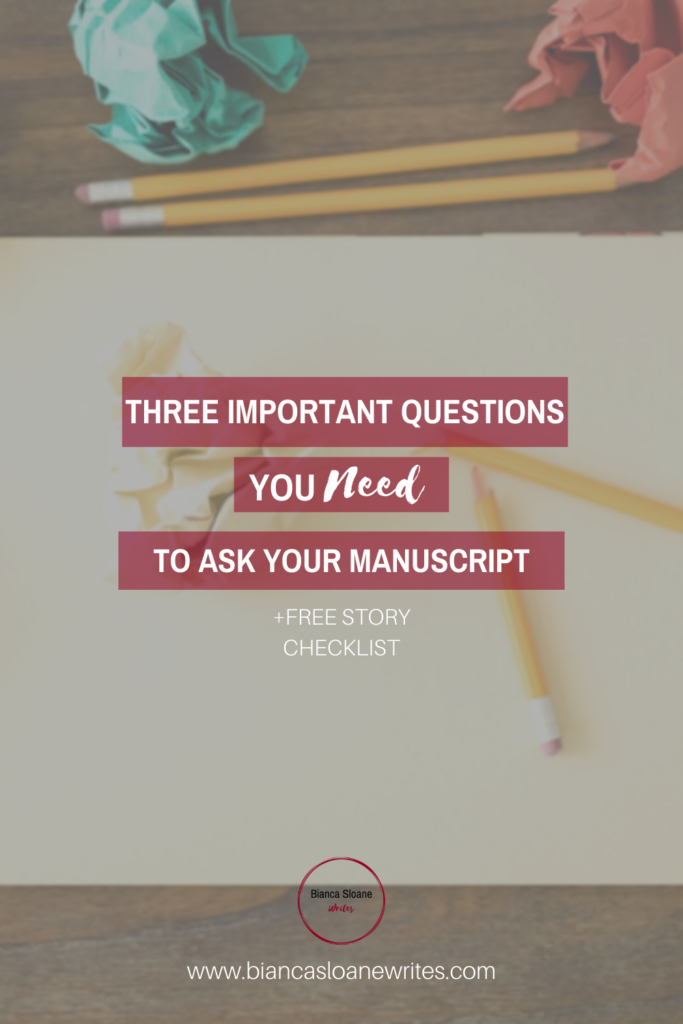Three Important Questions You Need To Ask Your Manuscript
The posts on Bianca Sloane Writes contain affiliate links, which may give a percentage of your purchases back to Bianca Sloane.
Reading a great book feels effortless. The characters are engaging, the setting strikes the right tone, the dialogue is crisp, the pacing is on point, and the cliffhangers keep you turning the pages.
It’s not until we sit down to craft our own amazing story that we realize how easy our favorite authors make it look.
Drafting a compelling story takes a lot of work and there’s a ton of moving parts to keep track of. For me, I concentrate on getting the first (crappy) draft down on paper. On that first pass, I almost always (like 99% of the time) forget to include things like any kind of physical description for characters, setting, or even a semblance of intelligible dialogue. It is during the subsequent multiple drafts that the characters come into sharper focus, setting is established, the dialogue gets cleaned up.

In other words, don’t despair if you feel like you’re forgetting things on that first pass. It’s why the concept of multiple drafts exist.
As you tackle your second, third, and fourth drafts, here are Three Important Questions You Need To Ask Your Manuscript:
1. Have I Described the Characters Physically?
As I said above, I almost never remember to do this on my first pass through a manuscript.
Now, admittedly, this one might stir up a bit of controversy. Some authors subscribe to the theory that you should shy away from specific physical description in order to allow the reader to fill in those details themselves.
In my opinion, what this actually means is, don’t over-describe what a character looks like or what they’re wearing. In other words, we don’t need to know about every mole, bump, or gray hair. Don’t describe your characters for the sake of describing them.
You can use physical description and wardrobe to give a picture of who that character is/what they’re about. For example, in the opening pages of the Danielle Steel novel, NEIGHBORS, she describes Debbie Speck as “heavy,” noting that “she dyed her hair blond herself.” This tells us Debbie may not have the money to go to the hair salon to have her hair professionally colored. Or maybe she can afford it, but finds it a waste of time. Or maybe it’s her “me” time (self-care is a thing, y’all).
In THE PELICAN BRIEF, by John Grisham, Tulane law professor, Thomas Callahan, is given the requisite, “faded jeans, tweed jackets with well-worn elbow patches, no socks, no ties,” that we might expect from an academic who lives in a humid climate. Grisham drops that Callahan is forty-five but could pass for someone a decade younger and that he only shaved once a week when his face started to itch. This all tells us Callahan isn’t overly fastidious in his appearance and favors comfort and practicality above all.
When working on what the characters look like, avoid bland descriptors like “beautiful” or “hot” or “ugly” or “impressive looking.” WHY are they beautiful, handsome, ugly or impressive looking? Are they tall, short, fat, have old acne scars, thinning hair, or a neck littered with moles? How do their clothes convey that they might be imposing?
In WAR AND REMEMBRANCE, when Natalie is reunited with her Naval officer husband, Byron, at the end of World War II she comments, “You really do look so imposing,” due to his dress whites.
Vivid descriptions add depth and richness to the characterizations.
Remember to give “beautiful” characters some physical imperfections such as a scar from a childhood accident, a crooked row of bottom teeth, or one brown eye and one blue. That “impressive-looking” guy could have a hook nose, be missing part of a finger, or have an eye patch. These imperfections make for interesting backstory AND offer opportunities for compelling dialogue.

It’s not necessary to describe a character to within an inch of their life. In fact, it’s distracting to do so. However, make sure to give the reader SOMETHING to hang their hat on.
“The only kind of writing is rewriting.”
― Ernest Hemingway
2. Have I Sharpened the Dialogue?
Dialogue carries a heavy load in a novel. It has to reveal character, establish conflict, contain subtext, be tight, not flabby, sound realistic, but not too realistic, as that’s boring, and move the plot forward.
Tall order.
A quick checklist on sharpening dialogue:
- Condense/eliminate monologues (unless it’s Dr. Hannibal Lecter schooling us on Clarice Starling)
- Scrap chit-chat (“Hi, how are you?” “I’m fine, how are you?” “I’m great, thanks for asking.”)
- Insert conflict by giving the characters opposing agendas (“I was wondering if I could take you out tonight?” “Sorry, I’m washing my hair.”)
- Include “off-putting,” or indirect responses (“Good morning.” “Where the hell were you last night?”)
- Give each character their own unique style and sound. They can stutter, talk slowly, talk quickly, swallow their words, have accents, use malapropisms, have catchphrases (Annie Wilkes in MISERY and her use of “Cock-a-Doodie”) use slang – the possibilities are infinite.
For inspiration, listen to conversations around you and take note of the cadence, tone, and speaking patterns. Study how your favorite authors craft conversations between characters and analyze the dialogue on your favorite TV shows and movies.
…don’t over-describe what a character looks like or what they’re wearing…
One of my go-to TV shows that I watch over and over again is ER. The heavy medical jargon never overpowers the superb dialogue (frankly, the more you watch the show, the more you start to understand what those terms mean.) Each time I watch, I find new little nuggets to learn from and appreciate.

Below are some examples pulled from the Season 8 episode, “Orion in the Sky,” which depicts a dying Dr. Mark Greene’s last shift in the ER:
Weaver: “How many shifts should I put you down for next month?”
Greene: “Never let your work become your life, Kerry.”
Carter (After Greene, who has an inoperable brain tumor, updates him on patients before he leaves the ER for the last time): “Anybody actually sick?”
Greene: “Just the doctor.”
Abby: Goodnight, Dr. Greene.
Greene: Goodbye.
Greene: “Clear sky. I’m outta here.”
Carter: “You in tomorrow?”
Greene (handling a basketball someone left in the ambulance bay): “Your ball needs air.”
Carter: “It’s not my ball.”
Greene: “You set the tone, Carter.”
Carter: “What?”
Greene: “Work on your jumpshot.”
Simple, spare, direct, yet full of rich subtext. Fantastic. (Watch the above dialogue in action here)
Read: Foundations of Fiction: How to Use Subtext for Stronger Dialogue
3. Have I Incorporated Sensory Detail?
In his MasterClass, James Patterson said during the first draft phase, he always writes two words at the beginning of his scenes:
“Be there.”
He calls it a reminder to himself to put the reader into the scene by including details on what the characters are seeing, hearing, touching, tasting, and smelling.
Using the five senses to flesh out such details as the nicotine-stained walls, sizzle of bacon, or the crunch of sand between bare feet while inhaling the salty sea air will paint vivid pictures that bring your story to life. Or, as Patterson says, help your reader, “Be there.”
Much like character descriptions, don’t go overboard on describing setting. We don’t need excruciating detail on what the characters are eating (unless food plays a major role in the story, like THE DINNER by Herman Koch), or exhaustive itineraries about what the character did from the moment they woke up until they left for work.
What are some of the questions you ask your manuscript during the revision process?


